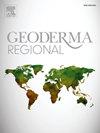Controlling factors of soil organic and inorganic carbon in North Adana, Türkiye
IF 3.3
2区 农林科学
Q2 SOIL SCIENCE
引用次数: 0
Abstract
In many soils of arid and semi-arid regions, the soil carbon pool consists of soil organic carbon (SOC) and soil inorganic carbon (SIC). Numerous studies have examined the relationship between the content of SOC and SIC in relation to various environmental factors. The northern region of Adana city in the Mediterranean region of Türkiye is characterized by a Mediterranean climate with about 600 mm of rainfall per year. Most studies in the region have focused on the impact of land degradation, such as urbanization and land use change, on stocks rather than the factors controlling SOC and SIC. The study area covered 9625 ha (>70 % Entisols) with an altitude ranging from 67 to 365 m. Soil samples were collected from 107 points at depths 0–30 and 30–60 cm, and from 17 pedons that were sampled by horizon. The spectral reflectance of the soil was measured using a vis-NIR spectrometer. SOC decreased with depth, while SIC increases regardless of land use. MAP and MAT did not show a significant effect on SIC concentrations. Soils derived from siltstone showed a large decrease in SOC concentration, while soils derived from conglomerate had an increase in SIC. High SOC concentrations were observed in the southern part of the region, while low SOC concentrations were observed from southwest to northeast of the study area. Dark colored soils had higher SOC and lower SIC values compared to light colored soils. In this area, SIC and SOC are controlled by soil characteristic and processes rather than by land use, topographic factors and rainfall and temperature.
北阿达纳地区土壤有机碳和无机碳的控制因素
在许多干旱半干旱区土壤中,土壤碳库由土壤有机碳(SOC)和土壤无机碳(SIC)组成。大量研究考察了有机碳和碳化硅含量与各种环境因素的关系。阿达纳市北部地区位于地中海地区基耶省,其特点是地中海气候,年降雨量约为600毫米。该地区的研究大多集中在城市化和土地利用变化等土地退化对土壤储量的影响,而不是土壤有机碳和碳化硅的控制因素。研究区海拔67 ~ 365 m,面积9625 ha(占总植被面积的70%)。在0 ~ 30 cm和30 ~ 60 cm深度的107个点上采集土壤样品,在17个样地上采集土壤样品。利用可见光-近红外光谱仪测量了土壤的光谱反射率。土壤有机碳随深度的增加而减少,而SIC随土地利用的增加而增加。MAP和MAT对SIC浓度无显著影响。粉砂岩系土壤有机碳含量显著降低,砾岩系土壤碳化硅含量显著增加。研究区南部有机碳含量较高,西南向东北方向有机碳含量较低。与浅色土壤相比,深色土壤的有机碳含量较高,SIC含量较低。本区碳化硅和有机碳受土壤特性和过程控制,而不受土地利用、地形因素、降雨和温度的影响。
本文章由计算机程序翻译,如有差异,请以英文原文为准。
求助全文
约1分钟内获得全文
求助全文
来源期刊

Geoderma Regional
Agricultural and Biological Sciences-Soil Science
CiteScore
6.10
自引率
7.30%
发文量
122
审稿时长
76 days
期刊介绍:
Global issues require studies and solutions on national and regional levels. Geoderma Regional focuses on studies that increase understanding and advance our scientific knowledge of soils in all regions of the world. The journal embraces every aspect of soil science and welcomes reviews of regional progress.
 求助内容:
求助内容: 应助结果提醒方式:
应助结果提醒方式:


